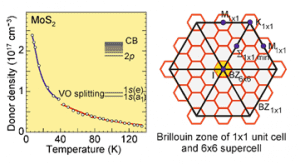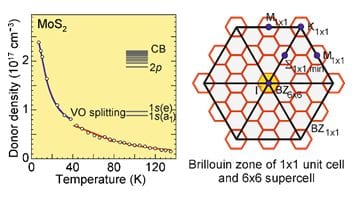Molybdenum disulphide (MoS2) has recently emerged as one of the most promising two-dimensional semiconductors. Impressive field-effect transistors, integrated circuits, phototransistors and sensors based on single and multilayers exfoliated from natural MoS2 have been demonstrated. However, the donor that gives rise to free carriers in the devices is still not known. Investigation of the electronic structure of the shallow donor using optical techniques such as photoluminescence is not possible since indirect-gap bulk MoS2 gives rise to no photoluminescence emissions while photoluminescence spectra in direct-gap monolayers show mainly band-to-band transitions.
 In MoS2, there are six equivalent conduction band minimums. In pristine crystals, their electronic states are degenerated. In the presence of a donor impurity, its central core potential will split up the degeneracy, causing the splitting of the ground state level of the donor, called the valley-orbit splitting. The valley-orbit splitting depends on the core potential of the donor and, hence, can be used for identification of the impurity. Combining electron paramagnetic resonance and density functional theory calculations, researchers at Linköping University, Korea Research Institute of Standards and Science, and Korea University of Science and Technology show that the shallow donor responsible for the natural n-type conductivity in bulk MoS2 is rhenium (Re) with a valley-orbit split of ~3 meV and an ionization energy of ~26 meV. Calculations show that the valley-orbit split of Re reaches the bulk value when the number of layers is larger than four and increases to ~97.9 meV in a monolayer.
In MoS2, there are six equivalent conduction band minimums. In pristine crystals, their electronic states are degenerated. In the presence of a donor impurity, its central core potential will split up the degeneracy, causing the splitting of the ground state level of the donor, called the valley-orbit splitting. The valley-orbit splitting depends on the core potential of the donor and, hence, can be used for identification of the impurity. Combining electron paramagnetic resonance and density functional theory calculations, researchers at Linköping University, Korea Research Institute of Standards and Science, and Korea University of Science and Technology show that the shallow donor responsible for the natural n-type conductivity in bulk MoS2 is rhenium (Re) with a valley-orbit split of ~3 meV and an ionization energy of ~26 meV. Calculations show that the valley-orbit split of Re reaches the bulk value when the number of layers is larger than four and increases to ~97.9 meV in a monolayer.
The text is kindly provided by Nguyen Tien Son

















